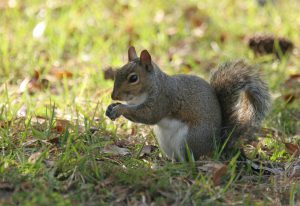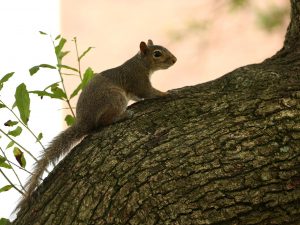This is a creature SO common, no one ever writes about them. When we discuss “local wildlife” we instinctively think of coyotes, hawks, and snakes. Creatures that we know about, but don’t know about at the same time. But that is not the case with the gray squirrel. Based on our interactions at public parks, nature trails, even mall parking lots – and certainly in our yards, this is one of the most commonly encountered members of the animal kingdom we have – but we do not know much about their lives. Not the way we do other members of our wildlife community.

We certainly know they are there. We see them every day. We know they feed on nuts and most of us know they dig holes all over the yard storing them for winter. We know there are a lot of them, and the occasionally we see (or hear) them fighting in the trees. As I mentioned in the territorial lesson (Wildlife Lesson 1), we also know they sometimes throw each other out trees. But there is much we do not know about their daily lives. Let’s take a closer look at them.
First, they are mammals – having modified scales called hair as a skin covering. Being mammals also means they are warm blooded and give live birth (no eggs). Mammals are divided into orders based on the type of teeth they have. The type squirrels have would place them in the order Rodentia – they are rodents. When we typically think of rodents, we think of mice and rats – some call squirrels “bushy tailed rats” – and they would be very close.
In Florida, we have three types of squirrels. The fox squirrel – which is much larger and a darker color than the gray squirrel. They reach about 10” in length and about three pounds in weight. It is a resident of the pine forest and prefers habitats that have been maintained by fire. Because of the lack of this, fox squirrels are a species of concern for extinction, and they are rarely found in our backyards.

Photo Pinellas County Government.
The flying squirrel is much smaller, being 8-10 inches long but only weighing in at 3-4 ounces – makes since because they have to “fly” (they really glide). They are usually nocturnal and sometimes can be found in our yards, I have had them in mind.
Then there is our old friend the gray squirrel – again, one of the most encountered animals in Florida yards. They are, of course gray, about 10 inches in length as well but weigh about a pound. As we already know, they frequent trees. They use many different kinds of trees for travel, but as we have discussed in other lessons, they prefer to nest in oak trees.
The nests are made of leaves and are quite visible in our yard. Inside they line their nests with chopped up bark and leaves. Here they give birth usually to 2-4 baby squirrels. They have two nesting seasons – late winter and mid-summer. The males fight aggressively to be the dad for these babies, but once they are born – mom can be quite aggressive, chasing away anything she does not want around her babies.
Having the classic gnawing teeth of rodents, squirrels eat a lot of nuts and fruit. They have their favorites – hickory nuts and pecans being two – but they will feed on just about any of them. I read one article that suggested they might even go for bird eggs in the trees, and insects.

Photo: Mississippi State University. A gray squirrel sits on a large oak limb.
We ALL know their fondness for bird feeders. It is amazing watching how they get around just about every “squirrel proof” bird feeder system we put out. They are fantastic acrobats, running threw the branches and jumping from tree to tree like it was nothing. You can see them run across power lines and try some very risky leaps to bird feeders we thought we had placed far enough out. And, after mentioning in another lesson that very few animals use palms, watching a squirrel sit in a palm tree feeding on some portion of the branches that produce the fruit later this year.
They are also amazing on the ground. Running and darting – jumping and leaping to get away from my dog Burnie. They have been clocked at 10-15 mph. One behavior they have, which is fun with the kids, is their habit of hiding on the other side of the tree from where you are.
Most of these are things we already knew but may not have paid that close attention to – because they are SO common. But here are a couple of things about squirrels you may not know:
– They are active primarily at dawn and dusk. Though they may be active all day on cloudy days. We will check that out in our activity today.
– They produce a variety of sounds and calls – barking, chirping, and many others.
– Though they rarely do, they are excellent swimmers. One article mentioned one swimming across a lake.
– They require about 2 pounds of food per squirrel per week – they eat a lot!
– They bury seeds and nut all over the yard for winter, and find them by smell.
– There can be as many as 10 males chasing each other to be the dad of baby squirrels.
– Males can require as many as 1-6 acres of trees for their range.
Again, they are amazing animals that we usually do not give a second glance to. Let’s do that now.
ACTIVITY
– Let’s see when they are most active. Set up a schedule today – like 9AM, Noon, 3PM, 6PM and count how many squirrels you see in your yard. You can do it every two hours if you wish, or even every hour (that will be hard). There should be more in the early morning and late afternoon – but let’s see.
– With all of the birds calling, it may be hard to hear their calls – but let’s try. Record what you hear when you see one making noise. What does it sound like? What do you think they are saying?
– If you find one on a tree – play the tree hiding game. Go to one side of the tree and see if they will go to there other. Keep going back and forth and see if they do the same. This is fun actually. 😊
AS ALWAYS – HAVE FUN AND STAY SAFE.
 0
0
